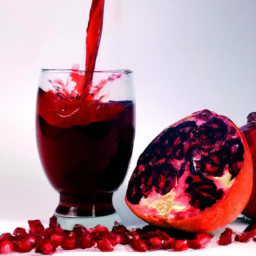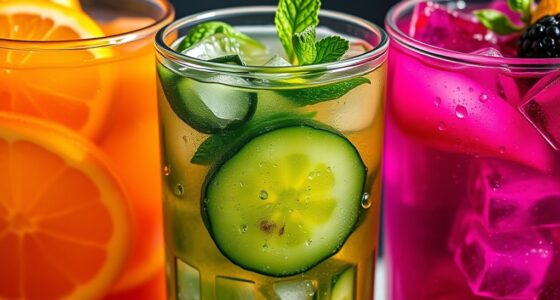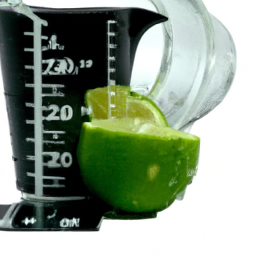As someone who loves food, it is evident to me that lime juice is essential in both cooking and mixing drinks. However, the amount of juice you can get from one lime can vary greatly, depending on different factors.
In this article, I will explore the different factors that affect the amount of juice in one lime, the typical juice yield, and provide tips for getting the most juice out of your limes.
Lime juice is not only a flavorful ingredient but also a nutritious one. It is a rich source of vitamin C, antioxidants, and other essential nutrients. Therefore, it is essential to know the correct amount of juice to use in your recipes to ensure you get the maximum nutritional benefits.
Join me as I delve into the world of lime juice and uncover the secrets to getting the perfect amount of juice from one lime.
Key Takeaways
- The amount of juice in one lime can vary greatly depending on several factors.
- Rolling the lime before cutting it open can help release more juice.
- Using a juicer or citrus press can extract more juice than squeezing with bare hands.
- One lime yields about 1-2 tablespoons of juice.
Factors That Affect the Amount of Juice in One Lime
If you want to maximize the amount of juice in one lime, you gotta give it a good roll on a hard surface before cutting it open! This is because the juiciness of a lime greatly depends on its ripeness. Limes that are fully ripe have higher juice content than those that are not yet fully developed.
Rolling the lime breaks down the cell walls inside the fruit and releases the juice, making it easier to extract. Another factor that affects the amount of juice in one lime is the juicing technique. Squeezing the lime with bare hands may result in less juice than using a juicer or a citrus press.
The latter methods apply more pressure on the fruit, allowing for more juice to be extracted. It’s also important to note that the temperature of the lime can affect the yield. Limes that are at room temperature will yield more juice than those that are cold.
Knowing these factors can help you get the most out of your limes when making your favorite recipes. Typical juice yield from one lime can vary depending on these factors, and it’s important to keep them in mind when measuring the amount of juice needed for a recipe.
Typical Juice Yield from One Lime
Squeezing a fresh lime can yield enough liquid to enhance the flavor of your favorite dish. The amount of juice you can extract from a lime depends on the variety of lime and the method of extraction. Some lime varieties, such as the Key lime, are smaller than the Persian lime, and may have less juice. However, Key limes are more acidic, which can affect the yield of juice. Using a lime juicer can also affect the amount of juice you extract from a lime.
To give you an idea of how much juice you can expect from a lime, here’s a table that compares the typical juice yield from two lime varieties, the Key lime and the Persian lime:
| Lime variety | Average juice yield per lime |
|---|---|
| Key lime | 2 tablespoons |
| Persian lime | 3 tablespoons |
Keep in mind that these measurements are just averages, and your own results may vary based on factors like the ripeness of the lime and the efficiency of your juicer. Nonetheless, lime juice is a great addition to many dishes, from marinades and dressings to cocktails and desserts.
Lime juice is a versatile ingredient that can add a pop of acidity to any dish. In cooking, it can help tenderize meat and brighten up flavors in sauces and salsas. In cocktails, it can give a refreshing twist to classic drinks like margaritas and mojitos. With its high content of vitamin C and antioxidants, lime juice also has nutritional benefits that can boost your immune system and help fight inflammation. So whether you’re a home cook or a professional bartender, lime juice is a must-have ingredient in your kitchen.
Importance of Lime Juice in Cooking and Cocktails
Using lime juice in cooking and cocktails adds a burst of tangy flavor that can liven up any dish or drink. But did you know that there are also many uses of lime juice beyond cooking?
Lime juice is packed with Vitamin C, antioxidants, and is a natural detoxifier. Consuming lime juice regularly can boost your immune system, aid in digestion, and even help with weight loss.
Aside from its nutritional benefits, lime juice is also a versatile ingredient that can be used in a variety of ways. It can be added to marinades, dressings, and sauces to add a zesty kick. It can also be used in cocktails to add a refreshing twist to classic drinks like margaritas and mojitos.
So, whether you’re looking to add some flavor to your meals or cocktails or simply want to reap the health benefits of lime juice, it’s definitely worth incorporating into your diet.
Speaking of incorporating lime juice into your diet, the next section will provide some tips for getting the most juice out of your limes without wasting any precious drops.
Tips for Getting the Most Juice Out of Your Limes
To maximize your lime’s potential, try rolling it on a hard surface before cutting and squeezing it. This helps to break down the fibers in the lime and release more juice.
Another technique is to microwave the lime for a few seconds before squeezing it. The heat helps to soften the lime and make it easier to extract the juice.
When it comes to juice extraction, the type of juicer you use can also make a difference. A manual citrus press is great for small amounts of juice, while an electric juicer can handle larger quantities.
Regardless of the method you choose, be sure to use firm pressure when squeezing the lime to get the most juice out of it. With these lime squeezing techniques, you can make sure you’re getting the most out of your limes and adding that extra burst of flavor to your cooking or cocktails.
Now that you know how to extract the most juice from your limes, let’s move on to the next step – figuring out how much lime juice your recipe needs.
How Much Lime Juice Your Recipe Needs
Wow, adding a zesty burst of lime juice to your recipe can take it from ordinary to extraordinary! But how much lime juice should you actually use? It all depends on the recipe and personal taste preferences.
For a general rule of thumb, one lime yields about 1-2 tablespoons of juice. However, keep in mind that limes can vary in size and juiciness, so it’s always best to taste and adjust as needed.
If you don’t have fresh limes on hand, you can use lime juice substitutes such as bottled lime juice or even lemon juice in a pinch.
It’s also worth noting that lime juice is not only a flavorful addition to your recipe, but it also has health benefits. Lime juice is rich in Vitamin C, antioxidants, and flavonoids, all of which can boost immune function and promote healthy skin.
So go ahead and add that lime juice to your dish, and don’t be afraid to experiment with different amounts to find your perfect balance of flavor. Now, let’s talk about the importance of adjusting lime juice to taste.
Importance of Adjusting Lime Juice to Taste
Now that we know how much lime juice our recipe needs, it’s important to adjust it to taste. Adjusting the flavor of lime juice can make a big difference in the outcome of your dish.
The tartness of lime juice can complement and balance out other flavors in your recipe, but too much can overpower them. On the other hand, if you don’t add enough lime juice, you may end up with a dish that lacks the brightness and freshness that lime juice can bring.
Customizing your recipe with lime juice can be done by adding it little by little until you reach the desired taste. It’s also important to taste the dish as you go, so you can make adjustments along the way. Remember that lime juice can vary in acidity and sweetness depending on the type of lime used, so be mindful of that when adding it to your recipe. Adjusting the lime juice to taste can make your dish unique and truly yours.
When it comes to using lime juice in your dishes, there are other factors to consider besides adjusting the flavor. Let’s take a look at some of these factors and how they can impact your recipe.
Other Factors to Consider When Using Lime Juice
When using lime juice in my recipes, I always consider its acidity level. This is because lime juice has a pH level of around 2.0 to 2.4, making it highly acidic. It’s important to balance this acidity with other ingredients to achieve the desired taste and avoid overpowering the dish.
Additionally, I also pay attention to pairing lime juice with other ingredients that complement its flavor profile, such as cilantro, garlic, and chili peppers, to enhance the dish’s overall taste and nutritional value.
Acidity
You’ll feel a tangy punch of acidity when you squeeze the juice of one lime into your drink. This is because lime juice is highly acidic and has a pH level of around 2.0 to 2.4. The high acidity levels in lime juice help to inhibit the growth of harmful bacteria and prevent spoilage, which is why it’s often used as a natural preservative.
Here are four ways the acidity of lime juice can benefit your health:
-
Helps with digestion: The acidity in lime juice can stimulate the production of digestive enzymes, which can help to break down food more efficiently and prevent digestive issues like bloating and constipation.
-
Boosts immunity: Lime juice is rich in vitamin C, which is a powerful antioxidant that can strengthen your immune system and protect your body against infections and diseases.
-
Aids in weight loss: The acidity in lime juice can help to regulate blood sugar levels, which can prevent overeating and promote weight loss.
-
Promotes healthy skin: The high levels of vitamin C in lime juice can also help to promote collagen production, which can improve the overall health and appearance of your skin.
Pairing lime juice with other ingredients can enhance its flavor and nutritional benefits.
Pairing with Other Ingredients
Combining lime with other ingredients can enhance its tangy flavor while also providing additional health benefits, making it a versatile ingredient in many recipes. Lime pairs well with many flavors and can be used in sweet or savory dishes.
For example, mixing lime juice with honey and garlic creates a delicious marinade for chicken, while combining it with cilantro and jalapeño can create a flavorful salsa. When it comes to recipe substitutions, lime juice can be used in place of lemon juice in most recipes. However, it’s important to note that the acidity levels of the two juices may be different, so adjustments may need to be made.
Similarly, lime zest can be used in place of lemon zest in recipes. Additionally, lime juice can be substituted for vinegar in salad dressings or used to add acidity to a dish instead of using wine or other acidic liquids.
Moving onto alternatives to fresh lime juice, there are many options available such as bottled lime juice or lime concentrate. However, it’s important to read the labels and check for any added sugars or preservatives. Another option is to use other citrus fruits such as lemon, orange, or grapefruit juice as a substitute.
Alternatives to Fresh Lime Juice
If you’re in a pinch and don’t have fresh lime juice, there are some great alternatives that will still give your dish that tangy kick you’re craving. One option is to use bottled lime juice, which can be found at most grocery stores. It may not have the same fresh flavor as squeezing a lime, but it does provide a convenient and consistent source of lime juice. Just be sure to check the ingredient list, as some bottled juices may contain added sugars or preservatives.
Another option is to use lime juice substitutes, such as lemon juice or vinegar. These acidic ingredients can provide a similar tangy flavor to lime juice, although they may not have the same complexity of flavor. You can also experiment with other citrus fruits, such as grapefruit or orange juice, for a unique twist on your recipe.
Overall, while fresh lime juice is usually the best option, there are plenty of alternatives available to suit your needs.
When it comes to storing lime juice, it’s important to keep it in an airtight container in the refrigerator. This will help preserve its flavor and prevent any bacteria growth. Additionally, you can freeze lime juice in ice cube trays for easy portioning in future recipes.
By taking these simple steps, you can ensure that you always have fresh-tasting lime juice on hand for all of your cooking and baking needs.
Storing Lime Juice
When it comes to storing lime juice, there are a few important factors to consider. First and foremost, it’s important to refrigerate the juice as soon as possible after juicing to prevent the growth of harmful bacteria.
Additionally, lime juice can also be stored in the freezer for longer-term use. However, it’s important to note that frozen lime juice may lose some of its nutritional value and flavor.
Refrigeration
Storing freshly squeezed lime juice in the fridge will keep it fresh for longer, so you can have a refreshing glass of limeade whenever the mood strikes you. Refrigeration slows down the growth of bacteria and other microorganisms that cause spoilage, extending the shelf life of your lime juice. However, it’s important to note that even when refrigerated, lime juice can only last for a certain amount of time before it goes bad.
To maximize the freshness of your lime juice, it’s best to store it in an airtight container and keep it in the refrigerator at a temperature of 40°F or below. According to the USDA, freshly squeezed lime juice can last for up to 2 weeks in the fridge. To help you keep track of how long your lime juice has been stored, here’s a table that shows the approximate shelf life of lime juice when refrigerated:
| Refrigerated Lime Juice Shelf Life |
|---|
| Up to 2 weeks |
Next, we’ll discuss how to freeze lime juice to make it last even longer.
Freezing
Freezing lime juice is an effective way of prolonging its shelf life. It can last up to 6 months when frozen properly. The process of freezing lime juice is easy and straightforward.
Start by squeezing the juice from the lime, and then strain it to remove any seeds or pulp. Measure the amount of juice you have, as this will determine the container size you will need.
When freezing lime juice, it’s important to choose the best containers to use. Glass jars or plastic containers with an airtight seal are the best options. Avoid using containers made of metal, as they can cause the juice to oxidize and change its taste.
Freezing lime juice retains its nutritional value, as it contains high levels of vitamin C, which is important for maintaining a healthy immune system. The benefits of freezing lime juice are many, including the convenience of having it on hand whenever you need it.
Frequently Asked Questions
What is the nutritional value of lime juice?
Lime juice is rich in vitamin C, antioxidants, and flavonoids, which offer numerous benefits such as boosting immunity, aiding digestion, and preventing chronic diseases. It can be used as a marinade, salad dressing, or added to water for a refreshing drink.
Can you substitute bottled lime juice for fresh lime juice in recipes?
I prefer using fresh lime juice in recipes due to the nutritional benefits. While bottled lime juice can be a convenient alternative, it may contain preservatives and lack the same flavor and acidity.
How long can you keep lime juice in the refrigerator?
Well, aren’t we all just dying to know how long our precious lime juice can last in the fridge? Fear not, my fellow juice enthusiasts. The shelf life of lime juice is around 2 weeks, but can be extended with proper storage tips such as using an airtight container and keeping it chilled. Now, about that one lime…
What are some common recipes that use lime juice?
I love using lime juice in cocktails and marinades. It adds a bright and tangy flavor that enhances the dish. Some common recipes include margaritas, ceviche, and grilled chicken with lime marinade. The nutritional benefits of lime juice include a high amount of vitamin C and antioxidants.
Are there any potential health risks associated with consuming too much lime juice?
Consuming too much lime juice can lead to potential toxicity due to its high citric acid content. The recommended daily intake is 1-2 limes, providing 30-60mg of vitamin C. Excessive consumption can also lead to dental erosion.
Conclusion
Well, there you have it folks – the answer to how much juice is in one lime! It all depends on the size and ripeness of the lime, but on average you can expect to get about 1-2 tablespoons of juice per lime.
Lime juice is an essential ingredient in many dishes and cocktails, providing a refreshing and tangy flavor. It also has health benefits, being rich in vitamin C and antioxidants.
So next time you’re squeezing a lime, remember to use the tips we’ve provided to get the most juice out of it and adjust the amount to your taste. As the saying goes, when life gives you limes, make some delicious limeade!
Ilana has been a vegan for over 10 years. She originally made the switch for health reasons, but soon found herself becoming more and more passionate about the ethical and environmental implications of a vegan lifestyle. Ilana is the author of The Graceful Kitchen, a blog all about veganism. She loves to cook up delicious and nutritious vegan meals, and share her recipes with others who are interested in leading a cruelty-free life. Ilana is also a strong advocate for using whole foods as the foundation of a healthy diet, and believes that going vegan is one of the best ways to achieve this.










